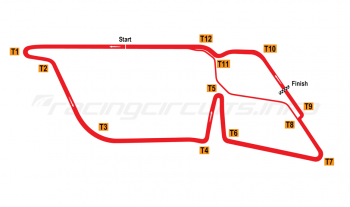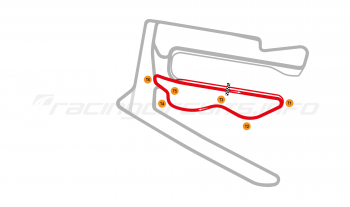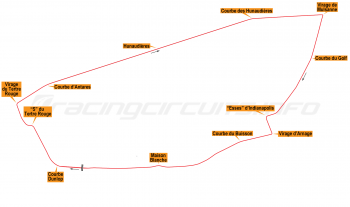Vancouver Pacific Place
Circuit Overview
For 15 years, Vancouver’s streets reverberated to the sound of high-powered single seaters, thanks to the annual visit of the Indycar race, sponsored by brewing giants Molson.
Making use of the streets and parking lots around the False Creek and Pacific Place areas of the city, once home to the pavilions of the Expo 86 exhibition, the race was popular among the fans, if not perhaps with the drivers or local residents.
Redevelopment of the area prompted several circuit changes but the Champ Car series dropped the race after 2004 after Molson decided the event’s business model was no longer viable. Attempts to revive the event as a Formula E race in 2022 faltered when agreement could not be reached with landowners.
Circuit History
Canada gained a second IndyCar street race in 1990 when, buoyed by the success of their Toronto event, brewing giants Molson put together a deal to bring racing to the streets of the British Columbian city.
The original circuit was centred around the BC Place football stadium, using a combination of city streets and land that was once part of the Expo ’86 world fair. The track proved tricky to master, with a compromised set up being required to find a balance between the fast and flowing section past the pits along Pacific Boulevard and the tighter sections on Expo Boulevard.
Spectating was largely confined the grandstands at the start/finish and on the approach to the Turn 3 hairpin, though a small set of bleachers also overlooked the Turn 5 chicane. Elsewhere the track had to squeeze around the BC Stadium and in-between the concrete pillars of two elevated highways and the Sky Train, limiting sight lines and even proving tricky for TV coverage.
Tragedy mars the first event
The first race was won by Al Unser Jr is what was his fourth win in a row for Galles-Krako Racing, which would ultimately help him secure that year’s championship title. However, the race is remembered for a tragedy which struck on lap 16 at the Turn 5 chicane.
Vancouver native Ross Bentley, in his first Indycar race, overshot the turn and stalled his Team-Kar Lola in the run off area. Track marshals quickly arrived and were able to bump Benltey, only to place themselves in the middle of the track just as the approaching car of Willy T Gibbs rounded the chicane. With the concrete walls obscuring his view until the last second, Ribbs had nowhere to go and was unable to avoid the group as they attempted to return to their posts. Marshal Bradley Weeks suffered a broken leg after being struck and thrown in the air by the rear wing of Ribbs’ Lola, but Jean-Patrick Hein was hot by the rear wheel and was then run over by the car. Two colleagues escaped with minor injuries.
A full course caution was ordered by race control and the cars were directed down the escape road as ambulances attended the scene. Hein was treated at the scene and rushed to St Paul Hospital but succumbed to his injuries later that night. He was just 22.
Following the race a distraught Ribbs, who finished tenth, was left anguished by the collision. "They jumped right out in front of me,” he told interviewers. “It was like they thought I was going to run into them while they were pushing the car... There was nothing I could do. Nothing."
Track evolves as area is developed
For the 1991 race, Turn One was opened out so that it became a sweeping left-hander, rather than the slightly clumsy chicane that had been used for the first event. Then in 1994, the Turn 7 chicane was modified into a ‘bust stop’ shape, though this didn’t do a huge deal to improve overtaking opportunities, which remained slim. Nevertheless the race remained popular with fans - indeed, by 1996 was attracting in excess of 100,000 spectators over the course of its weekends, setting single-day sporting event attendance record that year.
Michael Andretti took a brace of wins for Newman-Haas racing, before Al Unser Jr proved his mastery of the streets, taking three-in-a-row between 1993 and 1995. Andretti got his revenge in 1996, before Maurice Gugelmin took a fortuitous win, after race leader Bryan Herta was taken out at the chicane after the hairpin by Alex Zanardi, who had been trying to battle back onto the lead lap after several issues caused by brake trouble.
For 1998, development around Pacific Place meant that the track would need to relocate away from BC Stadium’s environs. A new course, which incorporated very little of the original, was established utilising a new loop for the northern shores of False Creek, down Quebec Street and onto a new loop constructed on waste ground to the south of the creek. The course actually only utilised a small portion of the city’s streets, with much of it purpose built for the races. Unusually, the southern loop incorporate a separate paddock and pit lane for the support series, the main Indycar paddock being too small to accommodate them.
Here the race settled for the remainder of its years, with the only change being the removal of a troublesome chicane on the run from Expo Boulevard onto Quebec Street in 1999. The new course was a slight improvement in terms of racing, but remained rather bumpy and narrow.
Dario Franchitti took wins in 1998 and 2002, with Juan Pablo Montoya and Roberto Moreno taking one apiece on the revised course. However, it was Canadian driver Paul Tracey who enjoyed the most success on this iteration of the circuit, taking wins in 2000, 2003 and the final event in 2004.
Molson pulls the plug
The final race still attracted a respectable race-day attendance of 63,000, though this was still well short of the numbers seen in the race’s hey day. The writing had seemed to be on the wall for several years, with the increasing numbers of condominiums springing up around the area putting land prices at a premium and bringing in a whole new crop of residents who were opposed to the disruption each year.
Adding further complication was the fact that the area was set to host the Olympic Village for the 2010 Winter Olympics, meaning the area used for the support paddocks and southern loop would be unavailable for racing. With financial challenges of its, Champ Car elected to drop the event from the schedule and Molson later confirmed it would not be prepared to continue supporting it. “The bottom line is the business model couldn't work,” Jo-Ann McArthur, president of the firm’s sports and entertainment division explained.
That seemed to be that, until another group of sports promoters began plans to revive the race, albeit as part of the all-electric Formula E championship. The Vancouver E-Prix was announced in 2021, with a new course set around the north and easter side of the creek set to be used. However, problems with negotiating land leases for the race meant that the event could not get approval for a permit from the city authorities and the event was dropped from the 2022 schedule. With the city’s mayor a sceptic from the outset, any chances of reviving the race for 2023 proved impossible and the race was finally consigned to history for good.
Jump onboard
Circuit info
This is a historic circuit which is no longer in operation.
Rate This Circuit
Votes: 1521
Location Information
With extensive redevelopment in the False Creek area, there’s very little evidence of the track today. The southern portion of the 1998-2004 track has vanished under condominiums and the Olympic Village, while the main pits and paddock area now houses the popular Concord Community Park.
Get your race tickets!
Brought to you with: 
We've teamed up with Motorsports Tickets to bring you the best deals for Formula One, MotoGP, Le Mans and more.













